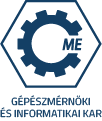| Course objectives: |
| Getting aquainted with the development and history of the most important optimization algorithms. Evolutionary optimization and technique. Kuhn- Tucker optimality criterium and the grapho- analytical optimization technique. Combining finite elements and optimization. Multiphysics finite elements. Introducing multidisciplinary optimization. Comparison of different optimization algorithms on the basis of their iteration history curves, analysis of sigmoid curves. |
| Course content and structure: |
| Short history of computers technique, CAD and finite elements. History and developments of optimization algorithms. Benchmark functions, local optimum, the Shekel- foxholes test function. Evolutionary algorithms, examples (RVA, BFA, AA, GA, PSA optimization algorithms). Introduction of the multidisciplinary optimization, combining finite elements and optimization. Multidisciplinary optimization in machine design. Numerical examples (gear noise, springs, journal bearings, etc). Usage of the internal programming language of some finite element systems (for example ANSYS, COSMOS/M, NX, ADINA, etc.) for multidisciplinary optimization. Shape optimization, topology optimization. Numerical examples for optimization and finite element analysis of several machine elements. CAD models given by the students will be optimized and/or finite element analysed as demonstration and consultation during the practical lessons. |
| Evaluation method: |
| Test containing ten questions concerning the topics shown during the lectures and practical lessons. The maximum possible points of the test is 100. The exam will be closed by a 5- grade mark. Points 0-39: failed (1); points 40-54: passed (2); points 55-69: average (3); points 70-84: good (4); points 85-100: outstanding (5). |
| Required reading: |
| Martin, H. C. ; Carey, G. F.: Introduction to Finite element analysis, Theory and application. McGraw-Hill Inc. New, York, 1976. Spunt, L.: Optimum structural design. Prentice Hall, Englewood Cliffs, N. J. 1971.Fox, R. L.: Optimization methods for engineering design. Addison- Wesley, Reading- London. 1971. |
| Suggested reading: |
| Haug, E. J., Arora, J. S.: Applied optimal design. Wiley- Interscience, New York, 1978. Zienkiewich, O. C.: The finite element method from intuition to generality, Applied Mech. Review, No. 3. Vol 23, pp. 249- 256. March, 1970. Mikhlin, S. G.: Variational methods in mathematical physics. Pergamon Press, New York, 1964. |


